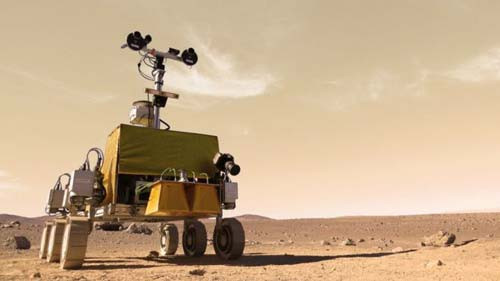Oxia: The land is first conquered on Mars
Scientists are building specialized robots sent to Mars to explore Mars's special equatorial region called Oxia Planum.
Search for life on Mars from Oxia Planum
Scientists developed robot models for ExoMars
This is a rich area of clay and minerals, the result of stone being weathered and weathered for a long time.
The specialized facilities of the ExoMars European Space Agency (ExoMars) will carry specific devices to look for signs of life in the Oxia region .

Source: E.ALLOUIS / AIRBUS DS.
The plan will begin to be put into practice from 2018.
However, if the hardware of the machinery and equipment is not developed in time, the plan will be delayed until 2020.
In that case, scientists and engineers will consider studying the other two regions on Mars, Mawth Vallis and Aram Dorsum .
Oxia Planum, is the most promising land for the first human exploitation and research on Mars.
Specific locations will depend on subsequent analytical results, based on scientific evidence and appropriate technical conditions.
Scientists must make sure that the mining and research robots can safely land on Mars thanks to the supporting parachute and rocket system.
In order to suit the above conditions, Oxia land must have a geographical condition with a length of about 100km and a width of about 15km to serve as a landing zone for robots. This location must not have cracks, the slope should not be too large and the soil should not be too big.
The US Aeronautics Agency (NASA) will help identify this location by taking a picture of the Oxia region with a high-definition camera mounted on a Mars-orbiting probe (Mars Reconnaissance Orbiter).

Source: NASA / MOLA.
Oxia Planum is the lowest area in the region. From a technical standpoint, this is a place with great conditions because it will be very difficult for the system to support even when having to land on a land with too large slopes.
In order to find signs of life, ExoMars robots will have to travel to areas with evidence of water.
The essential part of the program is that robots must be explored in places with truly ancient geological conditions. The rock in this place must be more than 3 million years old.
Oxia Planum is rich in clay and minerals, proving that it was once formed by the activities of rivers and deltas.
And the land of Mawrth Vallis contains a thicker layer of clay than Oxia but the location of this place is located in the North latitude so it is difficult for the robots to land safely on flights in 2018.
The Aram Dorsum region contains traces of a relatively large river system. Sedimentary stones around the rivers show traces of great floods that have appeared in this place.

Source: ESA / DLR / FU Berlin / NASA / MGS / MOLA.
ExoMars robots will not come to search in special areas that scientists now think are in liquid places.
These places have the oldest rock patterns showing evidence of the existence of water in the past. The rock and water source were formed from a very early stage in the development history of Mars. At that time, geographical and climatic conditions may be more appropriate for the existence of life.
Operation of robots and satellites belongs to ExoMars program
Robots will be equipped with support equipment and drilling systems to explore the surface of Mars.
This process will last at least 7 months but scientists hope that this period will be longer.

Source: ESA.
Russia and Europe lead the research program but the US will also participate.
The United States will provide telecom transponders and will start operating on a spacecraft flying around Mars orbit next year.
Satellite will also study the air condition and climate of Mars.
The satellite also has a landing gear and is designed in conjunction with inspection radar and guidance technology.
This system will also be landing on Mars between 2019 and 2021.

Source: ESA / S.CORVAJA.
- Going to bring hundreds of thousands of people to live in Mars?
- Is there extraterrestrial life at Oxia Planum - Mars?
- Mars exploration robots will land harassment
- The daring project conquered Mars
- NASA's seven-minute scare is about to land on Mars
- Locate the answer for Europe's Mars mission
- British doctors sell cheap land on Mars
- Claiming to inherit Mars from an ancestor, three men sued NASA for discovery without permission
- Search for life on Mars
- Arduous take Mars land to Earth
- What mystery of Mars awaits discovery?
- Imagine human life when settling down on Mars
 Van Allen's belt and evidence that the Apollo 11 mission to the Moon was myth
Van Allen's belt and evidence that the Apollo 11 mission to the Moon was myth The levels of civilization in the universe (Kardashev scale)
The levels of civilization in the universe (Kardashev scale) Today Mars, the sun and the Earth are aligned
Today Mars, the sun and the Earth are aligned The Amazon owner announced a secret plan to build a space base for thousands of people
The Amazon owner announced a secret plan to build a space base for thousands of people